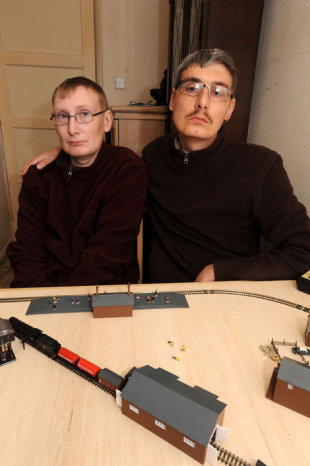CHICAGO
(Reuters) - Two international teams of scientists have identified a
rare mutation in a gene linked with inflammation that significantly
increases the risk for the most common form of Alzheimer's disease, the
first such discovery in at least a decade.
The findings,
published on Wednesday in the New England Journal of Medicine, offer new
insights into the underpinnings of Alzheimer's, a deadly, brain-wasting
disease that robs people of their memories, their independence and
their lives.
In separate studies, teams led by privately held deCode Genetics and John Hardy of University College London
found that people with a mutation in a gene called TREM2 were four
times as likely to have Alzheimer's as people who did not have the gene.
"It quadruples the risk of Alzheimer's," said Dr. Kari Stefansson of Reykjavik-based deCode in a telephone interview.
The level of risk
compares with ApoE4, the best-known genetic cause of late-onset
Alzheimer's, the form of the disease that occurs in older adults.
But this new gene
variant is 10 times more rare than ApoE4, which is present in about 40
percent of people with late-onset Alzheimer's.
Rare or not, scientists say the discovery represents a big breakthrough for Alzheimer's research.
"This is one of the most common, most devastating
illnesses in humans and we still don't have a very good understanding of
what causes the disease," said Dr. Allan Levey, director of the Emory
Alzheimer's Disease Center of Excellence in Atlanta, which helped
confirm the deCode findings.
"In my mind, this is very important. It gives us
another important clue as to one of the biological factors that
contribute to causing the disease," he said.
Despite numerous costly attempts, drug companies have
been stymied in their efforts to develop drugs that can alter the steady
course of Alzheimer's, which affects more than 5 million Americans and
costs the United States more than $170 billion annually to treat.
Current research efforts have focused on removing
sticky clumps of a protein called beta amyloid that accumulate in the
brains of people with Alzheimer's disease. But several drugs that have
been developed to remove these proteins have failed to produce a
significant improvement in patients with mild to moderate forms of
dementia.
With the new finding, researchers say the focus will turn on the role of inflammation in Alzheimer's disease.
INFLAMMATORY RESPONSE
TREM2 is a gene that affects a protein expressed on the
surface of cells in various tissues that "clean up garbage," Stefansson
said. These cells, called microglia, are often associated with
inflammatory response.
A genetic mutation that alters the function of these
housekeeping cells could affect how well the brain deals with an excess
of toxic proteins from beta amyloid, Stefansson and others said.
And that suggests that even though TREM2 is rare, the way it works in the brain may be important for brain health.
"It is certainly plausible that TREM2 is involved in
all of Alzheimer's disease," said Andrew Singleton of the National
Institute on Aging, who worked on the paper with Hardy and colleagues at
University College London.
"I think it may be very generalizable," Singleton said.
For their study, Hardy and colleagues used a number of
gene sequencing techniques to study 988 people with Alzheimer's disease
and 1,004 healthy volunteers.
The team also tested brain tissues from deceased
Alzheimer's patients, and they studied the expression of the TREM2 gene
in genetically engineered mice.
For the deCODE
study, researchers sequenced the genomes of 2,261 Icelanders and
identified variations likely to affect protein function. Then, they
looked specifically for these variants in people with Alzheimer's and
those with healthy brains, and found those with the TREM2 variant had a
significantly higher risk.
To make sure the
gene was not specific to Iceland, they replicated their findings in
populations at Emory University in the United States, as well as groups
in Norway, the Netherlands and Germany.
"We've essentially found exactly the same thing," said
Singleton of the NIA, which is part of the National Institutes of
Health. "In a way which you don't often see in science, the two studies
point in the same direction.
In July, a team at deCODE discovered a rare mutation in a gene called APP that protects against Alzheimer's.
"It is a complex
disease," Stefansson said. "I'm not surprised to see there are many ways
to bring about this deterioration in cognitive function."
Levey said while the TREM2 mutation is rare, it is likely changing the function of brain cells.
"It helps identify the microglial cells as an important possible (drug) target," he said.
Dr. Ralph Nixon,
director of the New York University Center of Excellence on Brain Aging
and a scientific adviser to the Alzheimer's Association, said the
findings suggest there are likely many more genes that increase the risk
of Alzheimer's disease.
"It's a good
illustration that we need to intensify this type of research and
identify what these genes are doing so we can finally translate it into
therapy," he said.



 By the looks of their home, Tony and Christine Clark are raising two
rambunctious 7-year-old boys. Model train tracks and Monopoly pieces are
scattered on tables and cartoons flicker on the TV set.
By the looks of their home, Tony and Christine Clark are raising two
rambunctious 7-year-old boys. Model train tracks and Monopoly pieces are
scattered on tables and cartoons flicker on the TV set.










